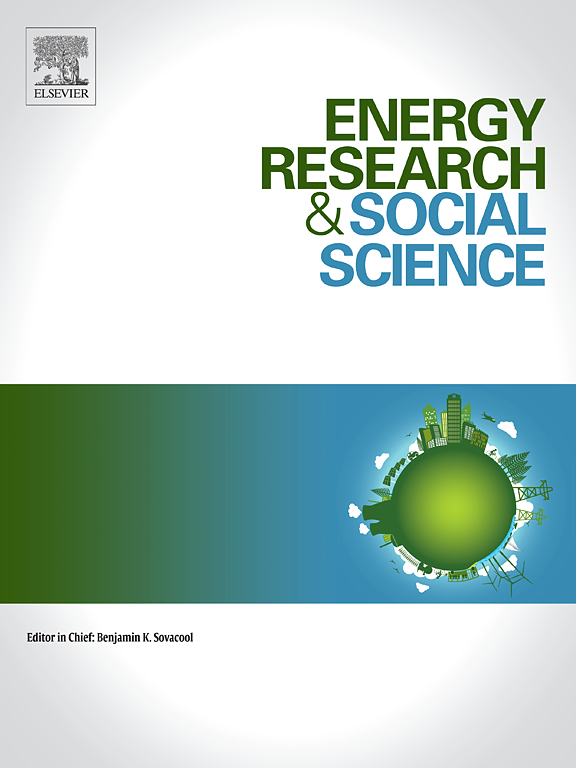脱离电网,站在围栏上:在孤立的微电网中解开电动汽车采用障碍
IF 7.4
2区 经济学
Q1 ENVIRONMENTAL STUDIES
引用次数: 0
摘要
减少温室气体排放是国际上从内燃机汽车(ICE)向电动汽车(EV)过渡的动力。虽然这种转变在世界上一些主要是城市化的区域正在迅速发生,但其他主要是农村和欠发达区域采用这种技术的速度较慢。阿拉斯加农村地区就是一个例子,那里的社区没有公路连接,电力成本高,环境条件极端,而且电网通常由柴油供电。本研究采用联合生产和混合方法来确定电动汽车采用的障碍和可感知的好处,并探索整个北极地区的电动汽车采用率。我们在阿拉斯加州的Bethel、Galena和Kotzebue举办了社区研讨会,并与企业和地方政府进行了25次访谈。电动汽车采用的五大障碍是无法在当地维护车辆,寒冷的天气性能,与内燃机汽车相比更高的购买价格以及电力成本。要在北极孤立的微电网社区成功采用电动汽车,需要投资适当的财政激励措施,特别是针对低收入家庭,扩大可再生能源发电,以及与气候和文化相关的概念验证车辆。居民们承认,电动汽车通常比内燃机汽车更清洁,燃料和维护成本更低,造成的空气和噪音污染也更少。我们建议制定政策框架,促进电动汽车在农村地区的普及。讨论了在全球偏远农村地区克服与向电动汽车过渡相关的挑战的政策影响。本文章由计算机程序翻译,如有差异,请以英文原文为准。
Off the grid and on the fence: Unpacking electric vehicle adoption barriers in isolated microgrids
Reducing greenhouse gas emissions is an international impetus to transition from vehicles with internal combustion engines (ICE) to electric vehicles (EV). While this transition is happening rapidly in some regions of the world that are mainly urbanized, other predominantly rural and less developed regions are slower to adopt this technology. Rural Alaska serves as an example with its not-road-connected communities, high cost of electricity, extreme environmental conditions, and isolated power grids often powered by diesel. This study used co-production and mixed methods to identify barriers and perceived benefits towards EV adoption and explore EV adoption rates across the Arctic. We conducted community workshops in Bethel, Galena, and Kotzebue, Alaska, and 25 interviews with businesses and local governments. The top five impediments to EV adoption are the inability to maintain vehicles locally, cold weather performance, higher purchase prices compared to ICE vehicles, and the cost of electricity. The successful adoption of EVs in isolated microgrid communities in the Arctic requires investments in appropriate financial incentives, especially for low-income households, expansion of renewable power generation, and climate and culture-relevant proof-of-concept vehicles. Residents acknowledged that EVs generally operate much cleaner than vehicles with ICE, can have lower fuel and maintenance costs, and cause less air and noise pollution. We propose a framework to develop policies to facilitate the adoption of EVs in rural areas. Policy implications for overcoming the challenges related to the transition to EVs in remote rural parts of the globe are discussed.
求助全文
通过发布文献求助,成功后即可免费获取论文全文。
去求助
来源期刊

Energy Research & Social Science
ENVIRONMENTAL STUDIES-
CiteScore
14.00
自引率
16.40%
发文量
441
审稿时长
55 days
期刊介绍:
Energy Research & Social Science (ERSS) is a peer-reviewed international journal that publishes original research and review articles examining the relationship between energy systems and society. ERSS covers a range of topics revolving around the intersection of energy technologies, fuels, and resources on one side and social processes and influences - including communities of energy users, people affected by energy production, social institutions, customs, traditions, behaviors, and policies - on the other. Put another way, ERSS investigates the social system surrounding energy technology and hardware. ERSS is relevant for energy practitioners, researchers interested in the social aspects of energy production or use, and policymakers.
Energy Research & Social Science (ERSS) provides an interdisciplinary forum to discuss how social and technical issues related to energy production and consumption interact. Energy production, distribution, and consumption all have both technical and human components, and the latter involves the human causes and consequences of energy-related activities and processes as well as social structures that shape how people interact with energy systems. Energy analysis, therefore, needs to look beyond the dimensions of technology and economics to include these social and human elements.
 求助内容:
求助内容: 应助结果提醒方式:
应助结果提醒方式:


